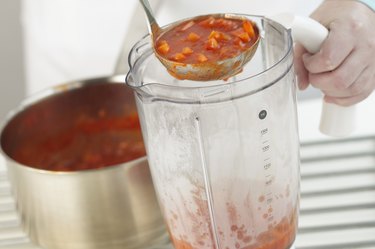
"Pureed" is a general term referring to food, usually cooked vegetables or raw fruit, that has been blended, processed or mashed so it has the consistency of a thick liquid. Common examples include mashed potatoes, applesauce and guacamole. Pureed food is necessary for babies and elderly people who have no teeth, but it can also benefit others if they take the time to mix it with saliva in the mouth.
Pureed Food
Video of the Day
"Pureed" is a French word that means purified or refined. Pureed foods are used in cooking to provide texture, better digestibility, enhanced flavor and decorative value, according to "Dictionary of Food Science and Technology." Pureed food is very similar to a thick soup, although usually preparation takes less time and involves fewer ingredients. "Coulis," another French word, refers to pureed fruit. Virtually all baby food is pureed because babies do not have teeth and cannot start the digestive process in their mouths. Elderly people who lose their teeth sometimes have to rely on pureed foods for their nutritional needs.
Video of the Day
Digestion
Digestion starts in your mouth and involves chewing your food and introducing it to saliva. According to "Medical Biochemistry: Human Metabolism in Health and Disease," your salivary glands produce about 1 L of saliva every day, and it is used for digestion, lubrication and even protection from bacteria. Chewing food physically breaks it up and provides more surface area for saliva and digestive juices in your stomach to act on it. Saliva contains an enzyme called alpha amylase, which begins the process of chemical digestion, particularly of carbohydrates. The food gets subjected to hydrochloric acid, bile and more enzymes as it passes from your stomach and through your small intestine.
Benefits of Pureeing Food
Pureeing food may enhance its flavor, but it obviously exposes more surface area of the food so your saliva and digestive enzymes can start metabolizing it. In essence, pureeing food is like chewing it hundreds of times. However, many people drink pureed food as they would liquids, which doesn't allow it to mix very well with saliva and may compromise digestion somewhat. Lightly chewing it or swishing it around in the mouth before swallowing allows it to mix with the saliva and also allows time for some nutrients to be absorbed directly through the mucosa of the mouth. Saliva is an important part of digestion, although more important factors include stomach acidity, bile secretion from your gallbladder and enzyme secretion from your pancreas.
Making Pureed Food
Pureed food is made in blenders and food processors or by mashing or straining. Mashed potatoes are a good example of a simple and quick pureed food. Pureed vegetables need to be cooked first in order to soften them, improve flavor, remove toxins and reduce water content, according to "Medical Nutrition and Disease: A Case-Based Approach." Swallowing pureed food is usually easy on your esophagus, the tube that runs from your mouth to your stomach.
Is this an emergency? If you are experiencing serious medical symptoms, please see the National Library of Medicine’s list of signs you need emergency medical attention or call 911.